What Are Deciduous Trees?


Deciduous trees are a fascinating and integral component of temperate ecosystems. These trees, which shed their leaves annually in response to changing weather conditions, are a perfect example of nature's adaptability and resilience. Found predominantly in regions with distinct seasonal variations, deciduous trees play a crucial role in maintaining ecological balance and providing diverse habitats for countless species.
In this article by thedailyECO, we will explore the definition of deciduous trees, their defining characteristics, the various types of deciduous trees and their ecological importance.
What are deciduous trees?
Deciduous trees, commonly referred to as broadleaf trees, are a group of trees that undergo a significant change in their foliage each year. Unlike evergreen trees that retain their leaves throughout the year, deciduous trees shed their leaves annually, usually in response to seasonal changes. This leaf-shedding process typically occurs during autumn, allowing the trees to conserve water and energy during the colder or drier months when photosynthesis is less efficient.
The hallmark characteristic of deciduous trees is their annual leaf shedding. This process is a survival strategy that helps the trees cope with unfavorable weather conditions. By dropping their leaves, deciduous trees reduce water loss through transpiration and minimize the energy required to sustain leaves that would not be productive in low-light or cold conditions.
Deciduous trees have evolved to thrive in climates with distinct seasonal variations, particularly temperate regions that experience cold winters and warm summers. Their ability to enter a state of dormancy during adverse conditions and resume growth when conditions improve is a key adaptation that enables their survival and proliferation.
While both deciduous and evergreen trees have developed strategies to cope with their environments, they differ significantly in their approach. Evergreen trees retain their foliage year-round, often with leaves that are tougher and more resistant to extreme weather. Deciduous trees, on the other hand, produce new leaves each spring, which are generally softer and more efficient at capturing sunlight for photosynthesis during the growing season.
It is important to note that the annual shedding of leaves contributes to soil enrichment. As leaves decompose, they add organic matter to the soil, improving its fertility and structure.
How do deciduous trees shed their leaves?
Deciduous trees have evolved a range of adaptations and characteristics that enable them to thrive in temperate climates, where they shed their leaves annually. These adaptations are crucial for their survival and play a significant role in their lifecycle.
One of the most distinguishing characteristics of deciduous trees is their annual leaf shedding, which typically occurs in autumn. The process of leaves falling in autumn is called abscission and is triggered by shorter daylight hours and cooler temperatures, signaling the trees to prepare for winter. Below, we explain the different steps involved in this process:
- As the days shorten in the fall, a reduction in the production of chlorophyll (the pigment responsible for photosynthesis) occurs. This leads to the visible change in leaf color.
- At the base of each leaf stem, an abscission layer forms. This layer cuts off the supply of water and nutrients to the leaf, causing it to die and eventually fall off. The abscission layer helps protect the tree from disease and dehydration.
- Before shedding their leaves, deciduous trees reabsorb valuable nutrients such as nitrogen and phosphorus from the leaves and store them in their roots and stems. This conservation of resources helps the tree survive through the winter and supports new growth in the spring.
- During winter, metabolic activities slow down, and trees rely on stored nutrients to survive until conditions improve.
- As temperatures rise and daylight increases in spring, stored nutrients are mobilized, and new leaves and shoots begin to grow. This period is characterized by rapid growth and increased photosynthesis.
- During the summer, trees maximize their photosynthetic activity, storing energy and producing seeds.
- In the fall, trees prepare for dormancy by shedding leaves and storing resources, and the process starts again.
Many deciduous trees have deep and extensive root systems that allow them to access water and nutrients from deeper soil layers. This adaptation is particularly useful during dry or frozen conditions.

Why do trees loose their leaves in autumn?
Maintaining leaves in winter can be energetically costly and inefficient for plants due to two key challenges. First, leaves are a major pathway for transpiration, the process where water exits the plant through evaporation.
In winter, when the ground is frozen and water is less accessible, keeping leaves would lead to excessive water loss. Shedding leaves helps plants conserve precious water during this dry period.
Second, winter's cold temperatures and shorter days significantly reduce photosynthesis rates – the process by which plants convert sunlight into energy.
With limited sunlight and cold temperatures, the energy a plant would expend maintaining leaves outweighs the minimal amount of energy it could generate through photosynthesis. In essence, it's more efficient for plants to shed their leaves and conserve energy for the colder months.
Why do leaves change their color?
The changing color of leaves in autumn is one of the most visually striking features of deciduous trees. This phenomenon, known as autumnal coloration, occurs as trees prepare to shed their leaves. Here’s why this happens:
- Chlorophyll, which gives leaves their green color, breaks down due to the reduction in daylight and temperature. As chlorophyll degrades, other pigments become visible.
- These pigments, which are always present in leaves, become visible as chlorophyll fades. They produce yellow and orange colors.
- These pigments are produced in response to bright light and excess plant sugars within leaf cells. They give leaves red, purple, and crimson hues.
Did you know there are countless varieties of trees beyond deciduous wonders? Explore the diverse world of trees, from evergreens to flowering giants, in another article on our site.
Examples of deciduous Trees
- Cherry (Prunus sp.): trees of the genus Prunus, cherries produce beautiful pink corymb flowers that mark the end of winter. Their fruit, cherries, mature by summer and are widely consumed.
- Almond tree (Prunus dulcis): also from the genus Prunus, the almond tree features attractive pink or white flowers. It is widely cultivated for its fruit, the almond.
- Walnut (Juglans regia): this tree can grow up to 25 meters tall and is valued for its wood, nuts, and ornamental appeal.
- Ginkgo biloba: known for its longevity, Ginkgo biloba is the sole species in its genus. It reaches up to 35 meters in height, has a pyramid-shaped crown, and distinctive light green, fan-shaped leaves.
- Japanese cherry (Prunus serrulata): this small but robust tree is widely planted for its ornamental beauty.
- Judas Tree (Cercis siliquastrum): this tree is admired for its stunning pink flowers and is highly resistant to extreme temperatures.
- Purple-leaf plum (Prunus cerasifera): this tree has white or pink flowers that bloom in late winter. It originates from Iran and was introduced around 1880.
- White Poplar (Populus alba): these trees can grow up to 30 meters tall and are noted for their white bark and branches.
- Russian Olive (Elaeagnus angustifolia): This deciduous tree grows quickly and is appreciated for its pleasant aroma and attractive foliage.
- White Ash (Fraxinus americana): typically large and fast-growing, the white ash can reach up to 40 meters in height. Its leaves turn a golden color in autumn.
- American Sweetgum (Liquidambar styraciflua): this tree is recognized for its leaves that change to purple and crimson. It grows slowly and has a pyramid shape in its youth. It thrives in fresh, deep soils that are not calcareous or acidic. Its origin is in the United States.
- Norway Maple (Acer platanoides): a well-known, rapidly growing tree with five-lobed leaves that turn yellow in the fall. It is robust, tolerates high pollution, and is adaptable to various soil types, although it prefers fresh soil. Many varieties exist.
- Rowan (Sorbus aucuparia): this tree has thick, straight branches, dark green leaves, and red fruits that grow in clusters. It grows slowly, is not demanding about soil types, and tolerates atmospheric pollution well.

If you want to read similar articles to What Are Deciduous Trees?, we recommend you visit our Outdoor plants category.







